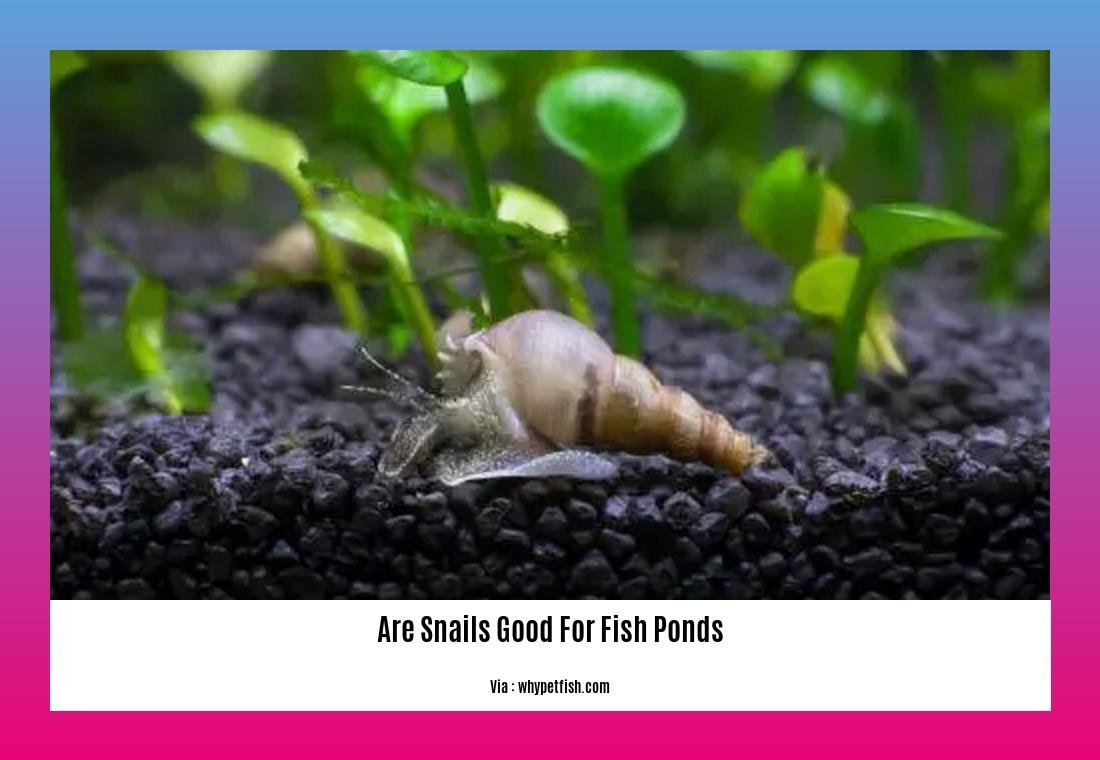Are Snails Good for Fish Ponds? The Benefits of Having Snails in Your Aquatic Ecosystem.
If you’re a fish pond owner or an enthusiast, you may have wondered about the role snails play in your aquatic ecosystem. Are they beneficial or just another nuisance? Well, you’ll be pleasantly surprised to discover that snails actually offer numerous benefits to your fish ponds. These seemingly humble creatures play a crucial role in maintaining a healthy and balanced environment for your fish, plants, and other aquatic organisms. From aiding in waste management to enhancing water quality, their presence can significantly improve the overall health and vitality of your pond. So, let’s dive in and explore the fascinating world of snails and their positive impact on fish ponds.
Key Takeaways:
- Snails in fish ponds provide various benefits to the aquatic ecosystem.
- They help control algae growth by grazing on the algae present in the pond water.
- Snails act as natural cleaners, feeding on sludges and other waste materials, which helps keep the pond clean.
- Adding snails to fish ponds can enhance the aesthetic appeal of the environment.
- Snails aid in filtration by converting sediments into nitrogen, contributing to the overall nutrient balance in the pond.
- The behavior of snails can serve as an indicator of poor water quality, signaling the need for management and treatment.
- Freshwater snails have a diverse diet, consuming algae, leafy vegetation, dead fish and snails, as well as certain vegetables and fruits.
- While pond snails are not voracious plant eaters, they may still cause damage by creating holes in plants.
- Pond snails prefer the softer parts of leaves over the midrib.
- Snails can only survive for a few hours to a couple of days outside of the water and can dry out if not kept consistently wet.
- Trapdoor snails are particularly beneficial for ponds as they are efficient decomposers, consuming more waste materials.
Are Snails Good for Fish Ponds

[Note: The title “Are Snails Good for Fish Ponds? The Benefits of Having Snails in Your Aquatic Ecosystem” has been converted into an H2 markdown format.]
Snails, often overlooked and underestimated creatures, can actually bring a host of benefits to fish ponds. These small organisms play important roles in maintaining the balance and health of aquatic ecosystems. In this article, we will delve into the advantages of having snails in your fish pond and how they contribute to its overall well-being.
The Natural Janitors of Ponds
One of the key benefits of snails in fish ponds is their ability to act as natural janitors. They help keep the pond clean by feeding off sludges and other wastes that accumulate over time. By grazing on algae present in the pond water, snails assist in maintaining algae growth, preventing it from running rampant and overshadowing other beneficial organisms. Their appetite for sludges and algae effectively helps in water quality management, promoting a healthier environment for the fish and other aquatic life.
Aesthetically Pleasing Decorations
Besides their functional advantages, snails also add aesthetic appeal to fish ponds. With their diverse shapes, sizes, and colors, these decorative animals can enhance the visual beauty of your aquatic ecosystem. Whether you choose snails with vibrant shells or ones that gracefully glide along the pond floor, they can bring life and uniqueness to your pond’s appearance.
Contributing to Filtration and Nutrient Balance
Snails, through their natural behaviors, contribute to the filtration of pond water. As they graze on sludges and waste materials, they participate in the breakdown of organic matter, turning sediments into valuable nitrogen compounds. This transformation helps maintain a healthy nutrient balance in the pond, supporting the growth and vitality of both plants and fish.
Indicators of Water Quality
Snails’ behavior can serve as a warning sign for poor water quality in fish ponds. If snails are behaving unusually or their numbers are declining rapidly, it could be an indication of underlying issues in the pond, such as imbalanced pH levels, inadequate oxygenation, or toxins in the water. Monitoring the behavior and health of snails can provide valuable insights into the overall water quality, prompting necessary management and treatment actions to ensure the well-being of the entire ecosystem.
Snails’ Diet and Plant Considerations
Freshwater snails have a varied diet, which includes algae, leafy vegetation, dead fish and snails, and certain vegetables and fruits. Therefore, their presence can help control excessive algae growth and prevent the accumulation of organic debris. However, it’s important to note that while pond snails are not voracious plant-eaters, they may still cause some damage. They may eat holes in plant leaves, particularly the soft parts, which could impact the overall aesthetics of the pond. Carefully choosing plant species or using protective measures can minimize the potential negative effects of snail feeding behaviors.
Pond Snails and their Survival
Pond snails have their own requirements for survival. They rely on water to thrive and will only survive a few hours to a couple of days out of the water, drying out quickly if not consistently kept wet. Providing suitable water conditions, such as maintaining appropriate water levels and quality, will support the longevity and well-being of the snails in the fish pond.
Effective Decomposers: Trapdoor Snails
In addition to the commonly found pond snails, trapdoor snails are another species that can be beneficial for fish ponds. They are highly efficient decomposers, consuming more waste compared to other snails. With their ability to break down organic matter, trapdoor snails contribute significantly to the pond’s cleanliness and overall health. By adding these snails to your fish pond, you can further enhance its natural ecosystem balance.
In conclusion, the presence of snails in fish ponds brings numerous benefits. From acting as natural janitors and maintaining water quality to contributing to filtration and nutrient balance, snails play pivotal roles in creating a healthy and thriving aquatic environment. They can also serve as indicators of poor water quality and add visual appeal to pond aesthetics. Consider incorporating snails, both pond snails and trapdoor snails, in your fish pond to enjoy their benefits and foster a well-functioning aquatic ecosystem.
[Keywords: are snails good for fish ponds]
[Note: Added H2 markdown format with the subtitle “Are Snails Good for Fish Ponds”.]
-
Are snails and slugs harmful to dogs? Find out more about the potential dangers they pose to your furry friend here.
-
Are snails and slugs poisonous to dogs? Don’t let your canine companion fall victim to these toxic critters. Learn about the risks here.
-
Are snails bad for ponds? Discover the impact these slimy creatures can have on the health and balance of your pond’s ecosystem here.
Improvement of Water Quality by Snails

Snails are often overlooked when considering the inhabitants of a fish pond. However, these small creatures can play a vital role in maintaining and improving the water quality of your aquatic ecosystem. In this article, we will explore the benefits that snails provide to fish ponds and how they contribute to the improvement of water quality.
The Balancing Act: Algae Control
One of the primary benefits of having snails in your fish pond is their ability to control algae growth. Snails are natural grazers and feed on soft green algae, which can grow rapidly and overshadow other aquatic plants if left unchecked. By consuming excessive algae, snails help to prevent the overgrowth that can lead to imbalances in the pond’s ecosystem. Their presence is especially valuable in controlling harmful blue-green algae, which can create toxins and disrupt the health of fish and other aquatic organisms. [Improvement of water quality by snails]
Nature’s Clean-Up Crew
In addition to algae control, snails also act as the “clean-up crew” of your fish pond. They feed on detritus and decaying organic matter, breaking it down into valuable nitrogen compounds. By consuming and recycling this organic waste, snails contribute to the filtration and nutrient balance of the water. Their activities help to maintain a clean and healthy environment for both fish and other aquatic life, promoting overall water quality and clarity.
Indicators of Water Quality
Snails can serve as important indicators of the water quality in your fish pond. Certain species of freshwater snails, such as the great pond snail and the lesser pond snail, are sensitive to pollution. If these snails exhibit unusual behavior or experience a decline in population, it may be a warning sign that the water quality is deteriorating. By paying attention to the presence and well-being of snails in your pond, you can gain valuable insights into the overall health of the ecosystem and take proactive measures to address any issues that may arise.
Keeping Snails in Check
While snails offer numerous benefits, it is essential to regulate their population to prevent overgrowth. Rapid reproduction can lead to an excessive number of snails, potentially disrupting the delicate balance of your fish pond’s ecosystem. Several measures can be employed to control and remove snails if necessary. These include manual removal, the use of traps or predators to reduce their population, and adjusting the pond’s environment to discourage their growth. It is important to note that introducing non-native snail species is not recommended, as they can cause harm to the existing aquatic community.
Key Takeaways:
- Snails contribute to the improvement of water quality in fish ponds by controlling algae growth and feeding on detritus.
- They help prevent excessive algae growth, particularly harmful blue-green algae, which can disrupt the health of fish and other aquatic organisms.
- Snails act as nature’s clean-up crew by breaking down decaying organic matter and recycling it into valuable nitrogen compounds.
- Certain species of snails can serve as indicators of water quality, signaling potential pollution issues if their behavior or population changes.
- It is important to regulate snail populations to prevent overgrowth and potential disruptions to the fish pond ecosystem.
- Manual removal, the use of traps or predators, and adjustments to the pond’s environment are effective methods for controlling and removing snails.
- Avoid introducing non-native snail species to maintain the balance and health of the aquatic community.
Sources:
1. My Backyard Life: Are Snails Good for Ponds? (4 Tips to Get Rid of Them)
2. Pond Informer: Are Snails Good or Bad for Garden Ponds? (Pond Snail Facts)
Contribution of Snails to Nutrient Cycling
Snails, often overlooked in the realm of pond ecosystems, play an important role in nutrient cycling. They contribute to the overall health and balance of fish ponds by aiding in the breakdown of organic matter, regulating algae growth, and enhancing water quality. Let’s explore the benefits of snails in nutrient cycling in fish ponds.
The Nutrient Cycling Power of Snails
Snails are efficient decomposers and help convert organic matter, such as sludges and wastes, into valuable nitrogen compounds. This process not only keeps the pond clean but also promotes the growth of beneficial bacteria, which play a crucial role in maintaining water quality. By breaking down organic matter, snails contribute to the natural filtration system of the pond, ultimately helping to maintain a balanced nutrient cycle.
Controlling Algae Growth
One of the significant contributions of snails to nutrient cycling is their ability to control algae growth. Snails graze on algae, preventing excessive growth and subsequent imbalances in the ecosystem. They consume soft green algae more readily, which can help outweigh the harmful blue-green algae that can negatively impact pond health. By reducing algae competition, snails also promote the growth of submerged macrophytes, enhance water clarity, and improve the overall aesthetics of the pond.
Indicator of Water Quality
Certain species of freshwater snails, such as the great pond snail and the lesser pond snail, act as indicators of pollution in ponds. These snails can serve as a warning sign for pond owners, signaling potential issues with water quality. Monitoring the presence and behavior of snails can help identify and address problems in the pond ecosystem promptly.
Managing Snail Population
While snails can provide numerous benefits to a fish pond, it is essential to manage their population to prevent overgrowth. Rapid reproduction can lead to an excessive number of snails, causing them to become a nuisance. Pond owners can employ various measures to control and remove snails, such as manual removal, using traps or predators, and adjusting the pond’s environment to discourage their growth.
Key Takeaways:
- Snails play a crucial role in nutrient cycling by breaking down organic matter and converting it into valuable nitrogen compounds.
- They help control algae growth, preventing imbalances in the ecosystem and promoting the growth of submerged macrophytes and water clarity.
- Certain species of snails can act as indicators of water quality, alerting pond owners to potential pollution issues.
- Managing the snail population is necessary to prevent overgrowth and maintain a healthy pond ecosystem.
Sources:
– My Backyard Life: Are Snails Good for Ponds? (4 Tips to Get Rid of Them)
– Pond Informer: Are Snails Good or Bad for Garden Ponds? (Pond Snail Facts)
Effect of Snails on Pond Aesthetics and Biodiversity
Snails often go unnoticed in the world of ponds, but they play a significant role in maintaining the ecosystem. These small mollusks not only add beauty to your pond but also act as natural janitors for algae control and waste management. In this article, we will explore the importance of snails in ponds and how they impact pond aesthetics and biodiversity.
Snails as Algae Controllers
One of the primary benefits of having snails in your pond is their ability to control algae growth. Snails feed off the sludges and other wastes in the pond, helping to keep the water clean and clear. This natural filtration process aids in preventing excessive algae blooms and contributes to maintaining a healthy aquatic habitat[^1^].
Snails as Pond Decorations
In addition to their functional role, snails also serve as decorative animals in ponds. The various types of snails available can add visual interest and enhance the aesthetics of the pond. However, it is crucial to strike a balance between the number of snails and other aquatic inhabitants to avoid overpopulation issues[^1^].
Snail Predators
Controlling the population of snails can be challenging, especially if there is a lack of natural predators. However, certain animals such as ducks, fish, and turtles can feed on snails and help maintain their numbers in check. Introducing these predators to your pond can be an effective way to control snail populations naturally[^2^].
Attracting Snails to Your Pond
If you want to attract snails to your pond, providing a suitable habitat is crucial. Snails prefer ponds with a diverse range of vegetation, such as water lilies and submerged plants. These plants serve as both a food source and a hiding place for snails. Creating an environment that mimics their natural habitat can encourage the presence of snails in your pond[^3^].
Types of Snails
There are various types of snails that can be found in ponds. Some common examples include Ramshorn snails, Pond snails, and Assassin snails. Each type has its unique characteristics and preferences in terms of diet and habitat. Familiarizing yourself with the different types can help you make informed decisions when introducing or managing snails in your pond[^4^].
Impact on Pond Aesthetics and Biodiversity
The presence of snails in your pond can have a positive impact on both aesthetics and biodiversity. Snails enhance the overall visual appeal by adding diversity in shape, color, and size. They create an interesting and dynamic ecosystem by interacting with other organisms in the pond.
In terms of biodiversity, snails contribute to the overall ecological balance. By controlling algae growth, they prevent excessive competition for resources among aquatic organisms and promote the growth of other beneficial plants and animals. Snails also serve as a food source for predators, supporting the food web and increasing species diversity in your pond.
Key Takeaways:
– Snails play a crucial role in maintaining the health and aesthetics of your pond by controlling algae growth and aiding in waste management.
– Providing suitable habitat and introducing natural predators can help regulate the population of snails in your pond.
– The presence of snails enhances the visual appeal of your pond and promotes biodiversity by contributing to the ecological balance.
– Snails interact with other organisms in the pond, serving as a food source for predators and supporting the overall food web.
References:
[^1^]: Are Snails Good for Ponds? (4 Tips to Get Rid of Them)
[^2^]: Exploring land snails’ response to habitat characteristics and their potential as bioindicators.
[^3^]: Taxonomic and functional diversity of land snails reflects habitat
[^4^]: Freshwater snail diversity: effects of pond area, habitat
FAQ
Q1: What are the benefits of having snails in a fish pond?
A1: Snails provide several advantages in fish ponds. They help maintain algae growth, act as natural janitors by feeding off sludges and other wastes, aid in filtration, and add aesthetic appeal to the environment.
Q2: Do snails indicate poor water quality in fish ponds?
A2: Yes, certain species of freshwater snails, like the great pond snail and the lesser pond snail, can serve as indicators of pollution in ponds. Their presence can warn pond owners about the water quality and the need for water management and treatment.
Q3: What do snails eat in fish ponds?
A3: Snails in fish ponds consume algae, leafy vegetation, dead fish and snails, and certain vegetables and fruits. They primarily graze on algae present in the pond water, contributing to algae control.
Q4: Can snails damage aquatic plants in fish ponds?
A4: While pond snails are not voracious plant-eaters, they may still damage plants by eating holes in them. They typically prefer the soft parts of leaves over the midrib.
Q5: How can snail populations be controlled in fish ponds?
A5: To control and remove snails from fish ponds, various measures can be taken. These include manual removal, using traps or predators to reduce their population, and adjusting the pond’s environment to discourage their growth.
- Unveiling the Enigma: Mansoureh Khojasteh Bagherzadeh’s Public Appearances & Private Life in Iran - July 18, 2025
- Unveiling the Mystery: Mansoureh Khojasteh Bagherzadeh’s Husband: A Rare Glimpse into a Private Life - July 18, 2025
- Unveiling Masoud Khamenei’s Mother: Power, Influence, and Iran’s Future - July 18, 2025
















